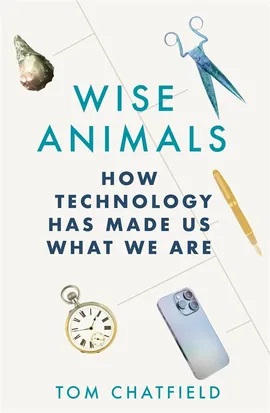Consider a chimp peeling a stick which it will poke into a termite nest. It strikes us as a human gesture. Our primate cousin is fashioning a tool. Just as important, the peeled stick implies a narrative. Chimp is hungry, will deploy this neat aid to catch termites that lie beyond normal reach, and eat them.
The example comes from historian of technology David Nye, but makes a point that recurs throughout Tom Chatfield’s excellent book. Any technology is part of a story. That holds for the chimp, whose story is implicit. It remains true in the high-tech 21st century, when the commercial for the latest model phone is a 20-second tale of how it will transform your life into innumerable flawless videos of smiling people enjoying perfect moments.
Nowadays, of course, the stories are more obviously motivated, and the futures they proclaim often contested. So it’s important to establish some principles for thinking about technology. We are probably aware that leaving technology to the market means we’ll get new tech that maximises profits rather than actually making life better. But acting on that means having a better handle on how the human-made world is a composite of stories-and-machines: imagination materialised.
Chatfield, a technology journalist with an interest in philosophy, is an excellent guide to the terrain. His definition of technology is properly broad – “the entirety of human artefacts that extend our grasp of the world” – and he wants to go beyond the persistent tendency to see technology as just the next wave of innovation, while those inventions and devices we are used to are just “stuff”.
Those two starting points mean his book roves over the entirety of human history, and even earlier. He sketches how we have shaped our environment, since the adoption of fire and flints, and how it has then reshaped us. Humans and their technologies are in a continually unfolding dance, and the co-production that ensues is cognitive as well as material. Writing is a technology. So is map-making. And your smart phone, properly considered, is an extension of your mind, not just a hand-held gadget.
All that is dealt with in the first half of the book. For Chatfield’s subtitle undersells what he offers in two ways. His view, which draws on a reading of just about every thoughtful commentator on technology, is much more complex and satisfying than “technology has made us what we are”. And he is interested in where we allow technology to take us next, not just how we got to now.
 His examination of that in part two is less all-embracing. It has to be, as the possibilities technology offers grow and grow. Old technologies constantly enable new ones, and get recombined in new ways. The sometimes dizzying ramifications of this combined cultural and technological evolution are exhilarating and anxiety-provoking in equal measure.
His examination of that in part two is less all-embracing. It has to be, as the possibilities technology offers grow and grow. Old technologies constantly enable new ones, and get recombined in new ways. The sometimes dizzying ramifications of this combined cultural and technological evolution are exhilarating and anxiety-provoking in equal measure.
Chatfield’s approach to future tech focusses mainly on the electronic realm – computers, connectedness, artificial intelligence, self-driving cars, and so on. There’s a helping of psychology, neuroscience, and cognitive science to help us get our bearings. And he proceeds using the principles he has laid down earlier, along with some new ones.
The book is packaged to look a bit like one of those “here’s a Big Idea that explains all of human history” efforts, but Chatfield is far too thoughtful and scrupulous a writer to offer yet another of those. Indeed, he hangs each chapter on an idea about technology that he insists is wrong, or a delusion as he calls them. This continual arguing against particular propositions does give the text a slightly negative cast, but the more complex view he builds up is really necessary to even begin to do justice to his subject. He usually succeeds in following his own advice, with only a few lapses. For instance, he rejects the popular notion that we will unite with our technologies, or be subsumed by them, in some kind of post-human transcendence. Nevertheless, he still seems to fall into the rhetoric of the “delusion of perpetual progress” when he writes that “we are embarked on an exponential path to something unprecedented.” Could the singularity beckon after all?
His overall insistence that the form technology takes is not pre-determined, its consequences never inevitable, is more important, though. And he is clear that even as we avoid a too-simple technological determinism, it’s vital to recognise that values, goals and relationships can be – and usually are – built into new technologies early in development, and can be hard to shift.
Again, that’s a point that is mainly underlined by examples from current developments in computing and data manipulation. There are plenty of things here to worry about, although more from other fields would have broadened the book’s appeal. There’s nothing much here about the energy systems we currently need to rebuild completely, for example, or on weapons, and hardly anything relating to the life sciences.
Those omissions are excusable, if only because there are plenty of books about those things. A couple of others strike me as more serious. He doesn’t really entertain the notion that technologies may take forms derived from human psychopathology. There seems to be a default assumption here that people are basically well-intentioned. But the possibilities advanced technologies offer those whose main aim is to dominate others, or even to destroy the whole shebang, are a trifle worrying. Perhaps Chatfield is just too nice to dip into the dark prospects such a consideration would demand.
He also holds back, more disappointingly, from giving us much about how to get involved in shaping our technological futures. He explains the need for a new ethics of technology, with a whole chapter on what kind of ethics to go for. But it’s not clear how it might ever get adopted. Yes, we need to get better at creating “virtuous cycles” of technology development. But how?
The book does pose the question, but is light on examples that might help answer it. A brief account of how the Algorithmic Justice League grew out of an MIT grad student’s realisation that facial recognition systems incorporate racial bias is about the only one. Chatfield gestures hopefully toward “mindful delay, dissent, and disavowal” as options, and suggests they must be put on firm foundations. But there are few pointers here to how they might be usefully enacted. The problem, perhaps insurmountable, is that most of us workers, citizens or consumers have little or no access to technology at its inception, or ways of influencing its path. Whether we have thought up any better techniques for doing that as modern technological trajectories have accelerated in the last few hundred years isn’t clear. My proof copy of Wise Animals lacks an index, but if there is any discussion of the Luddites I missed it.
- Wise Animals: How Technology Made Us What We Are, (Panmacmillan, £20)
- More book reviews on theartsdesk















Add comment